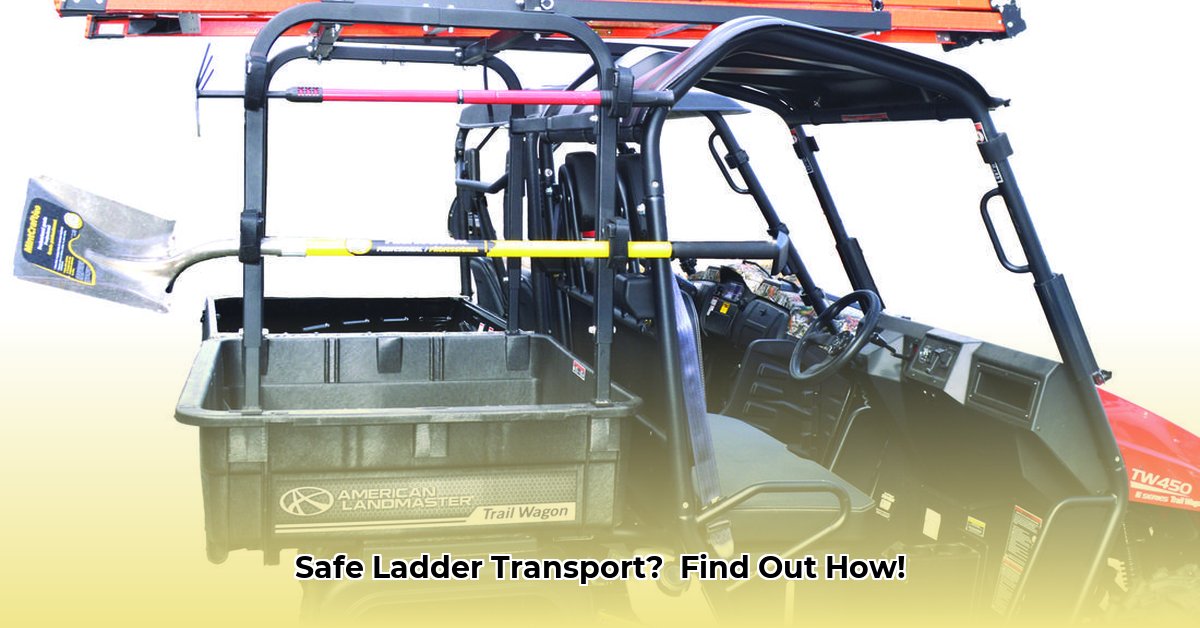
Working safely at height on your farm is crucial for efficiency and sustainability. A secure ladder rack for your tractor is vital equipment for this. This guide provides step-by-step instructions for selecting, installing, using, and maintaining a ladder rack, emphasizing safety and longevity—key elements of sustainable agricultural practices. For tractor parts, check out our recommended supplier here.
Choosing the Right Ladder Rack
Selecting the appropriate ladder rack requires careful consideration of several factors. The wrong choice can compromise safety and efficiency. What are your specific needs?
- Ladder Size and Weight: Measure your ladders. The rack's weight capacity must exceed the total weight of all ladders you'll transport. Overloading is a major safety hazard.
- Material and Durability: Durable, rust-resistant materials like steel or aluminum are preferable. These minimize replacements, reducing waste and aligning with sustainable practices. Consider the climate; aluminum resists rust better in humid environments.
- Tractor Compatibility: Ensure the rack is compatible with your tractor's mounting points. A poor fit compromises stability and safety. Consult your tractor's manual or your local Tractor Supply store for guidance.
- Budget: While a high-quality rack represents a worthwhile investment, balance cost with your budget and long-term needs. A durable rack requires fewer replacements, saving money in the long run.
Safe Installation and Mounting Procedures
Improper installation is a significant safety risk. Follow these steps meticulously:
- Read the Manual: Thoroughly review the manufacturer's instructions before starting. Every rack is different.
- Secure Mounting: Use the correct bolts, nuts, and washers specified in the instructions. Over-tightening can damage the rack or tractor.
- Even Weight Distribution: Ensure the rack is mounted to distribute the weight of the ladders evenly across the tractor. Uneven weight can affect handling and stability.
- Post-Installation Check: After installation, re-check all bolts and fasteners to ensure they are securely tightened.
Secure Ladder Transportation Techniques
Safe transport is paramount to prevent accidents and damage. Follow this sequence:
- Pre-Loading Inspection: Inspect ladders for damage before loading. Damaged ladders should not be used.
- Even Loading: Load ladders carefully, maintaining balance and avoiding overloading any section of the rack.
- Secure Fastening: Use appropriate straps or tie-downs to secure ladders to the rack, preventing movement during transit.
- Pre-Transit Check: Before driving, conduct a final inspection of the secured ladders and the rack's attachment to the tractor.
Maintenance and Longevity: Extending the Life of Your Ladder Rack
Regular maintenance is key to maximizing your ladder rack's lifespan and minimizing waste.
- Regular Cleaning: Clean the rack after each use to remove dirt, debris, and corrosive materials.
- Inspection: Regularly inspect for loose bolts, cracks, rust, or damage to any component.
- Lubrication: Lubricate moving parts as recommended by the manufacturer to reduce wear and maintain smooth operation.
- Prompt Repairs/Replacements: Address any issues promptly. Ignoring minor problems can lead to major failures.
Troubleshooting Common Issues
Addressing problems early prevents escalating damage and potential accidents.
- Loose Bolts: Tighten loose bolts immediately using the correct tools. Consider using locking nuts to prevent future loosening.
- Damaged Components: Repair or replace damaged parts promptly. Replace any damaged components rather than attempting risky repairs.
- Rust: Clean and apply a rust inhibitor. For future purchases, consider rust-resistant materials.
Don't wait for problems to become major issues! Regular maintenance is cheaper and safer.
Case Studies: Sustainable Farming in Action
Farmers across the country use ladder racks on their tractors daily; it isn't just about convenience but also about responsible farming. Examples showcasing safe and efficient rack usage in varied agricultural settings demonstrate how these racks contribute to sustainable agricultural practices. (Further detailed case studies are planned for future publications.)
Key Takeaways:
- A secure ladder rack is an essential investment for safe and efficient farm work at height, enhancing overall productivity and sustainability.
- Careful selection, proper installation, and regular maintenance are critical for ensuring the safety and longevity of your ladder rack.
- Prioritizing safety through regular inspection and prompt repairs is crucial for minimizing accidents and maximizing the effectiveness of your ladder rack.
Remember, responsible use and maintenance of your ladder rack directly contribute to a safer and more sustainable farming operation.